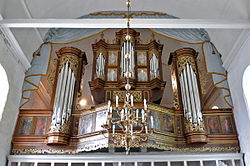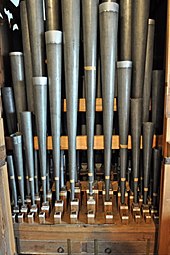Organ by St. Martini et Nicolai (Steinkirchen)
| Organ by St. Martini et Nicolai (Steinkirchen) | |
|---|---|

|
|
| General | |
| alternative name | Schnitger organ |
| place | St. Martini et Nicolai, Steinkirchen |
| Organ builder | Arp Schnitger |
| Construction year | 1685-1687 |
| Last renovation / restoration | 2012 Rowan West |
| epoch | Baroque |
| Organ landscape | between Elbe and Weser |
| Technical specifications | |
| Number of registers | 28 |
| Number of rows of pipes | 46 |
| Number of manuals | 2 |
| Tone tract | Mechanically |
| Register action | Mechanically |
The organ of St. Martini et Nicolai in Steinkirchen was built by Arp Schnitger from 1685 to 1687 and is one of his best-preserved organs. The instrument from his early creative period has 28 stops on two manuals and a pedal .
Building history
Previous instrument
Already at the beginning of the 16th century the church had a small organ, which an unknown organ builder set up on the north wall near the altar and which was probably the first organ in the Altar Land. The instrument had a range of Fg 2 a 2 , so it was based on a 6 'pitch. Four registers from this organ are completely or partially preserved and can be identified from the Gothic inscriptions on the pipes. In 1581 Dirck Hoyer ( Hamburg ), Jacob Scherer's son-in-law , added a chest movement with five stops on a second manual in the Renaissance style . The contract for this organ building project is still in place and is one of the oldest organ building documents in the Old Country. Arp Schnitger expanded the organ in 1682 and moved it to the new church in 1683.
New building by Schnitger 1685–1687
In the course of the west gallery built in 1687, Schnitger was commissioned to build a new organ. He designed an organ with main and breastworks as well as two lateral pedal towers in the gallery parapet. As is often the case with a new building, Schnitger probably adopted six fundamental registers from the previous organ, which could be integrated into his sound concept. The oldest pipes of the Octav 4 ′ in the main work have Gothic inscriptions that are very similar to those in the organ in Harsefeld . His journeyman Claus von Eitzen worked on the new building. In 1691 the organ case and the trapezoidal parapet were painted. An inscription points to Schnitger's organ building: “ANNO 1687 this organ was completely rebuilt during the IURA | TEN Peter Hauschild. Peter Gahrn. and Hannß Beye. Vonn Meis | ter Arp Schnitkern, organ maker from Hamburg. "
The five-axis prospectus of the main housing has a raised polygonal central tower and two pointed towers on the outside. Two-storey pipe fields mediate between the towers under a joint, profiled cornice. In the upper flat fields the pipes are mute. The frieze in the profiled base wreath bears the inscription: "Glory to God alone". The free-standing pedal towers are integrated into the gallery parapet. All the pipe fields close at the top and bottom with a gilded veil, which also crowns the main movement case and is attached to both sides of the pedal towers. The sawed-out flat decorations get their three-dimensional effect through their painting.
The valuable instrument in Steinkirchen is a work from Schnitger's early creative period that has a rich disposition with 28 parts for a village organ . A large part of the registers from Schnitger's new building have been preserved: 18 complete (six of them wholly or partially using older parts) and six partially. It is remarkable that the original intonation has not been significantly changed. In addition to Schnitger's organ in Cappel , the organ in Steinkirchen was therefore often used for music recordings, which made the instrument widely known. The prospectus and the pipework served as a model for the organ in St. Elisabeth Hamburg-Harvestehude by Rudolf von Beckerath (1951).
Later work
Schnitger repaired the organ himself in 1704. Further repairs were carried out in 1763 by Johann Matthias Schreiber and in 1769 probably by Dietrich Christoph Gloger . In 1773 the decorative wooden curtain with painted stucco was attached and a flat panel with silent pipes between the housings of the main and pedal units, but the side veils and the crowns on the pedal towers were removed . The veil work on the main work case was replaced by the pipe covers connecting the case of the pedal and manual work. In 1775, the organ builder Georg Wilhelm Wilhelmy from Stade replaced the Gedackt 8 ′ in the pedal with an Octave 8 ′ during renovation work , renewed the foiling of the front pipes and sealed the bellows. Today's Zimbelstern with harmonious bells also comes from Wilhelmy. He received 612 marks for the renovation. His son Johann Georg Wilhelm Wilhelmy took care of the maintenance work until 1840.
In 1843, Philipp Furtwängler serviced the instrument, although it is unclear what activities he carried out for 325 Reichstaler . As a result, it is not possible to determine with certainty who was responsible for the loss of additional original votes. Between 1862 and 1929 Johann Hinrich Röver and his son Heinrich Röver were responsible for the maintenance of the organ. In 1893 Heinrich Röver Schnitgers replaced six wedge bellows with a magazine bellows and in 1909 the wooden cover in the breastwork with a cover made of metal; only five bass pipes remained.
Restorations
In 1947/1948 the first restoration was carried out by Rudolf von Beckerath Orgelbau (Hamburg), who handled the pipework very carefully and did not change the original intonation as much as possible. However, Schnitger's keyboards were replaced. Von Beckerath removed the dummy pipes between the cases and restored the veils on the pedal towers, but not on the main works. In 1955, the case was given a new color version . Another restoration was carried out by von Beckerath in 1987 and 1991. He reinstalled the removed but fortunately kept Schnitger keyboards and reconstructed exchanged registers and six wedge bellows. Except for the Octav 8 ′ in the pedal, Schnitger's disposition was restored.
In 2012, Rowan West reconstructed the mixture and reworked Beckerath's Cimbel. The inconsistent and incompletely preserved historical mixture pipes were stored in the organ. West corrected the function of the action and wind supply and created Werckmeister III (modified) as a historical tuning, which could be reconstructed using the soldered covered pipes and probably goes back to Wilhelmy (1775).
His investigations into pipe dating led to new results of the complex structural history of the organ. The Rohrflöte 8 ′ and Nassat 3 ′ registers, which were previously ascribed to Hoyer (1581), date from the late Gothic period, i.e. the early 16th century. Quinta 3 ′, which was previously assigned to the Schnitger school, goes back to the late Schnitger workshop, as Schnitger's inscriptions show. It stands on the loop of the otherwise usual NassatQuint 1 1 ⁄ 3 ′, which was probably originally intended. Krumphorn 8 ′ also comes from Schnitger, only the throats go back to Hoyer.
Disposition since 1775
|
|
|
||||||||||||||||||||||||||||||||||||||||||||||||||||||||||||||||||||||||||||||||||||||||||||||
- Coupling : sliding coupler II / I (S)
- Tremulant (S)
- Cimbelstern (Wi)
- Remarks
- ↑ C – e Schnitger, from f Hoyer.
- ↑ F – g 2 a 2 late Gothic, remainder Schnitger.
- ↑ C – g late Gothic, from g sharp Schnitger, who rebuilt an original 4 ′.
- ↑ Cylindrical.
- ↑ Reconstructed, old pipe inventory from the first half of the 17th century stored.
- ↑ Eichenholz, C – G Schnitger.
- ↑ Conical, from Schnitger's workshop, is written on the loop of the originally planned NassatQuint 1 1 ⁄ 3 ′.
- ↑ 11 pipes reconstructed.
- ↑ Kehlen from F by Hoyer, otherwise new by Schnitger.
- ↑ From older pipe material.
- V = from the late Gothic predecessor organ
- Ho = Dirck Hoyer (1581)
- S = Arp Schnitger (1685–1687)
- Wi = Georg Wilhelm Wilhelmy (1775)
- B = Rudolf von Beckerath (1987 and 1991)
- RW = Rowan West (2012)
Technical specifications
- 28 registers, 46 rows of pipes
-
Wind supply :
- 6 wedge bellows (Beckerath)
- 3 shut-off valves (Schnitger / Beckerath)
- Wind pressure: 72 mm water column
- Windchest (Schnitger)
- Action:
- Keyboards: manuals (Schnitger), pedal (Wilhelmy)
- Tone action: mechanical
- Stop action: mechanical
-
Mood :
- Well-tempered tuning (Werckmeister III, modified)
- Pitch: about 3 ⁄ 4 tone above a 1 (483 Hz at 16 ° C)
literature
- Thurston Dart: Practica musica. From dealing with early music . A. Francke, Bern 1959, ISBN 3-87697-009-1 , p. 44 .
- Gustav Fock : Arp Schnitger and his school. A contribution to the history of organ building in the North and Baltic Sea coast areas . Bärenreiter, Kassel 1974, ISBN 3-7618-0261-7 , p. 79-82 .
- Peter Golon: Historic organs in the Stade district . Schaumburg, Stade 1983, ISBN 3-87697-009-1 , p. 65-66 .
- Konrad Küster, Hans Tegtmeyer (ed.): God alone, honor - the wealth of organs in the old country . [Landschaftsverband Stade], [Stade] 2007, ISBN 978-3-931879-31-0 , p. 35 (catalog for the exhibition from June 7th to August 26th, 2007).
- Harald Vogel , Günter Lade, Nicola Borger-Keweloh: Organs in Lower Saxony . Hauschild, Bremen 1997, ISBN 3-931785-50-5 , p. 174-177 .
- Cornelius H. Edskes , Harald Vogel : Arp Schnitger and his work (= 241st publication by the Society of Organ Friends ). 2nd Edition. Hauschild, Bremen 2013, ISBN 978-3-89757-525-7 , pp. 36-37, 173-174 .
Recordings / sound carriers
Web links
- Organ guide of the Steinkirchen parish (PDF file; 156 kB)
- Arp Schnitger organ database
- Organ in Steinkirchen at NOMINE eV
- Photos and information about the organ
- Page by H.-W. Coordes
- Greifenberg Institute for Musical Instrument Studies
- Schnitger's early style on ndr.de (broadcast on April 28, 2019)
Individual evidence
- ^ Vogel, Lade, Borger-Keweloh: Organs in Lower Saxony. 1997, p. 177.
- ↑ a b Edskes, Vogel: Arp Schnitger and his work. 2nd edition 2013, p. 173.
- ↑ a b Fock: Arp Schnitger and his school. 1974, p. 80.
- ^ Vogel, Lade, Borger-Keweloh: Organs in Lower Saxony. 1997, p. 174.
- ↑ a b c d Edskes, Vogel: Arp Schnitger and his work. 2nd edition 2013, p. 36.
- ↑ Küster, Tegtmeyer: God alone the honor - the wealth of organs in the old country. 2007, p. 35.
- ↑ Fock: Arp Schnitger and his school. 1974, p. 81.
- ^ Website of H.-W. Coordes zu Steinkirchen , accessed March 3, 2018.
- ↑ Information on restoration (PDF file; 54 kB), accessed on March 3, 2018.
Coordinates: 53 ° 33 ′ 37.5 ″ N , 9 ° 36 ′ 27.1 ″ E



